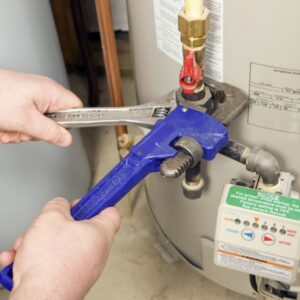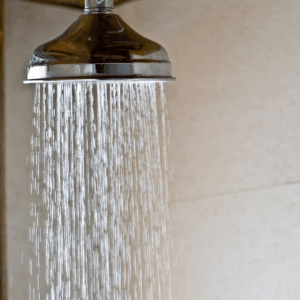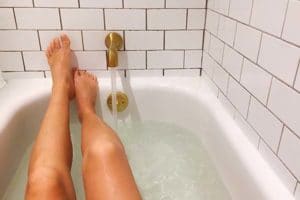Not much thought goes into choosing a toilet. After all, it’s something we use every day without giving it much attention! But when it comes time for a bathroom renovation or replacing an old unit, suddenly it becomes a decision worth careful consideration.
While picking the right toilet isn’t the most complicated choice you’ll make, there are several factors to consider, especially if you want to set a realistic budget and avoid surprises.
In this post, we’ll break down everything you need to know about toilet installation costs, including the key factors that influence pricing, what to expect when hiring a professional, and practical tips for making smart, cost-effective decisions.
- Typical Cost Range: Toilet installation in Australia varies from AUD $150 for budget-friendly toilets to AUD $1,000 (or more!) for luxury models.
- Additional Costs: Plumber rates depend on experience, location, and project difficulty. Most installations take a few hours, but tight spaces or older plumbing can increase costs.
- Toilet Type Influences Price: Close-coupled toilets are affordable and easy to install, while wall-hung, back-to-wall, and smart toilets require more work and higher costs.
- Installation Complexity: Replacing an existing toilet is simpler and cheaper than installing one requiring new plumbing or structural adjustments.
- Additional Costs: Extra expenses may include old toilet removal, plumbing repairs, permits, tile adjustments, and water efficiency upgrades.
- DIY vs Professional Installation: DIY may work for simple replacements, but mistakes can cause leaks, damage, and void warranties. Licensed plumbers ensure proper fitting, compliance, and warranties.
- Planning and Budgeting: Considering all factors, type, labour, additional work, and compliance, helps homeowners budget accurately and avoid surprises.
Understanding Toilet Installation Costs
Installing a toilet in Australia usually costs between AUD $150 and AUD $500+, but this range can expand depending on several factors. This estimate typically includes labour, materials, removal of your old toilet, and functional testing to ensure everything works correctly. While it may seem straightforward, several elements can influence the final price.
What Affects the Total Cost?
- Labor Costs: Plumbers may charge a flat rate or an hourly fee, with most standard installations taking 2–3 hours. More complex jobs or difficult-to-access bathrooms can increase labour charges.
- Toilet Type and Features: The toilet itself often makes up the largest portion of the cost. Simple, standard models are more affordable, while premium or high-efficiency toilets (and smart toilets with advanced features) can significantly increase the price.
- Installation Complexity: Replacing an existing toilet is generally less expensive than installing one in a new location without existing plumbing. Wall-mounted toilets or units requiring structural adjustments also cost more due to additional work.
- Location and Accessibility: Tight spaces or bathrooms with limited access can make installation more challenging, adding time and labour costs.
- Additional Work Required: Unexpected plumbing repairs, damaged floors, custom fittings, or even electrical work for smart toilets can all increase the total cost.
- Emergency or After-Hours Service: If you need installation urgently or outside standard business hours, plumbers often charge extra for the convenience.

Types of Toilets and Their Price Impact
Different types of toilets come with varying costs for the unit itself and installation. Here’s a breakdown of the most common options in Australia:
Close-Coupled Toilets
Close-coupled toilets are the most common choice in Australian homes. The cistern sits directly on top of the toilet bowl, making it a compact and straightforward design. Their simplicity makes them popular; they’re affordable, easy to maintain, and fit well in most bathrooms.
Prices range from as little as AUD $150, with high-end models costing as much as AUD $1,000. These toilets are easy to install because they follow standard plumbing setups, which keeps labor costs low as well.
Wall-Hung and In-Wall Cistern Toilets
Wall-hung toilets offer a modern, “floating” design, with the bowl mounted on the wall and the cistern concealed within it. In-wall cistern systems not only look sleek but save floor space and make cleaning easier.
Prices generally range from AUD $200 to AUD $5,000 or more. Installation is more complex as it requires wall reinforcement and specialised plumbing skills, which means labour costs can be twice as high as standard models.
Smart Toilets and Bidet Combos
Smart toilets are at the luxury end of the market. They include features like auto-flushing, built-in bidets, seat warming, and even adjustable water temperature. Prices start at AUD 1,000 and can go as high as AUD $6,000, with ultra-premium models costing as much as AUD$ 20,000
These toilets offer convenience and comfort, but installation usually requires both a plumber and an electrician, increasing overall costs. If you’re primarily interested in bidet functionality, standalone bidet attachments are a more affordable option, costing AUD 305.80 to AUD 764.50 to install.
Back-to-Wall and Wall-Faced Toilets
Back-to-wall and wall-faced toilets sit flush against the wall with a hidden cistern, giving bathrooms a tidy, streamlined appearance. Both styles reduce cleaning effort since there’s no gap between the toilet and wall for dust or grime to collect, but can be more difficult to maintain or repair if needed. They cost AUD $280 to AUD $500+
One-Piece vs Two-Piece Toilets
One-piece toilets combine the tank and bowl into a single unit, offering a sleek look and easier cleaning. Prices are AUD $500 to $AUD 1,300. Two-piece toilets have separate tanks and bowls joined by bolts. They are more affordable, costing AUD $250 to AUD $700. While easier to move and install, they can leak between parts and require more cleaning effort.

Labour and Installation Complexity
When it comes to toilet installation, labour costs and the complexity of the job play a major role in your overall budget. In Australia, plumbers typically charge between AUD $80 and AUD $120 per hour. Most standard toilet installations take 2–3 hours, which means labour costs usually fall between AUD $160 and AUD $240.
Plumbers usually include several fees in their pricing:
- Call-out fee
- Hourly rate
- Installation fee
- Toilet and material cost
A reputable plumber will provide a detailed, upfront quote so you know exactly what you’re paying for. Always ask for a breakdown to avoid surprise charges.
How Location and Access Affect Pricing
Where you live can affect labour costs too. City plumbers often charge more because of higher demand and living expenses, while rural installations might be cheaper (though additional travel fees may apply).
Bathroom accessibility is another major factor. Tight spaces, hard-to-reach areas, or unusual layouts can extend installation time and require special tools, increasing labour costs. Older homes with outdated plumbing or multi-story buildings with tricky pipe access also tend to take longer to work on.
Additionally, if new plumbing is required, such as installing water lines, relocating waste pipes, or upgrading outdated systems, this adds both time and cost to the project. Any modifications to existing plumbing, including repairing leaks, replacing corroded pipes, or adjusting pipe placement for non-standard toilets, can significantly increase labour charges.
- Standard installations: A simple toilet replacement generally takes 1–2 hours.
- Complex installations: Jobs involving wall-mounted toilets, smart toilets, or plumbing repairs can take 3–5 hours or more.
Same-Day or Emergency Installation Fees
Urgent toilet installations may come at a premium. Emergency and after-hours plumbing can cost 50–100% more than regular rates. Some city plumbers offer same-day installations with priority service fees. While more expensive, these services are invaluable when dealing with urgent issues like leaking toilets that could damage floors.
Additional Costs to Consider
While the price of the toilet and labour form the bulk of your installation budget, there are several additional costs that homeowners might overlook. These include:
- Old Toilet Removal and Disposal: Removing and disposing of your old toilet may seem simple, but it can add to your project costs if not included in your installation package. Some plumbers handle this as part of their service, while others charge separately. Proper disposal often depends on local regulations, and some council waste facilities accept old toilets at no extra charge. Factoring this in early ensures your project stays on track.
- Plumbing Upgrades or Repairs: Hidden issues may emerge once your old toilet is removed. Corroded pipes, blockages, or improperly positioned plumbing may need attention before your new toilet can be installed. Common repairs include drain line fixes, flange replacements, or in some cases, relocating plumbing to suit the new model. Addressing these issues is essential for a functional and long-lasting installation.
- Permit Requirements and Compliance: To comply with Australian standards, all toilets must be WaterMark certified, ensuring they are safe, fit for purpose, and suitable for use in Australia. (Check for the WaterMark trademark on the product or packaging, and verify the unique licence number in the WaterMark Product Database.) Installation must be carried out by a licensed plumber to meet National Construction Code (NCC) requirements, which covers the toilet’s location, dimensions, and clear space. For renovations or extensions, local permits may also be required, so checking with your council beforehand helps ensure all legal and safety obligations are met.
- Custom Fittings or Tile Adjustments: Sometimes your new toilet may not perfectly fit the existing space. Minor tile cutting or floor adjustments might be necessary, and previous water damage could require repairs. Accounting for these potential customisations prevents unexpected delays and keeps your bathroom looking polished and functional.
- Water Efficiency Upgrades: Many regions now require the installation of water-efficient, certified toilets. While these models often cost more upfront, they can provide long-term savings on water bills and may qualify for government rebates. Choosing a certified high-efficiency toilet ensures compliance with regulations while promoting sustainability in your home.
DIY vs Hiring a Professional
In some cases, DIY toilet installation can be an option, particularly if you’re replacing a similar model, your existing plumbing points line up perfectly, and no changes to the water supply or drainage are needed. However, even small mistakes, such as improper levelling or poor sealing, can lead to costly water damage.
DIY installations carry several risks, including leaks that harm your home’s structure, injuries or broken fixtures from mishandling, loss of manufacturer warranties that require professional installation, and poorly fitted parts that cause slow leaks or unpleasant odours.
Hiring a licensed plumber offers peace of mind.
Professionals bring certified expertise, ensure compliance with regulatory standards, and typically provide warranties on their work. They use commercial-grade tools to install toilets quickly and correctly, carry insurance to protect against accidents or mistakes, and guarantee proper alignment, secure connections, and thorough testing. For most homeowners, the added cost of professional installation is outweighed by the reliability, safety, and long-term savings it provides.
Helping You Plan Smart
Ultimately, toilet installation costs vary widely depending on the type of toilet you choose, the complexity of the installation, and any additional plumbing or renovation work required. From budget-friendly close-coupled models to high-end smart toilets, knowing what influences costs helps you plan effectively and avoid costly surprises.
While DIY installation may seem tempting, hiring a licensed plumber ensures proper fitting, regulatory compliance, and long-term peace of mind. With expert tradesmen available across Perth, GA PERRY makes the process easy, reliable, and stress-free, so you can enjoy a functional, stylish bathroom without the headaches. Book your toilet installation today and take the guesswork out of your next bathroom upgrade!



